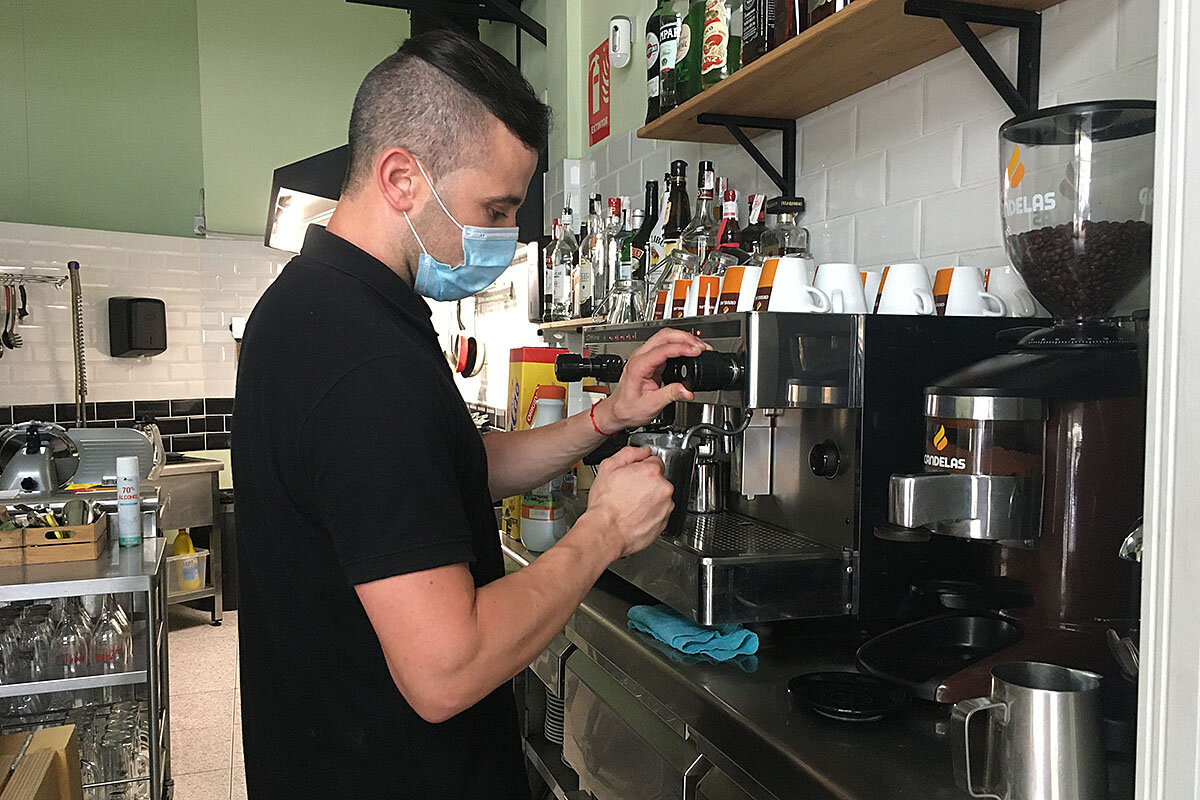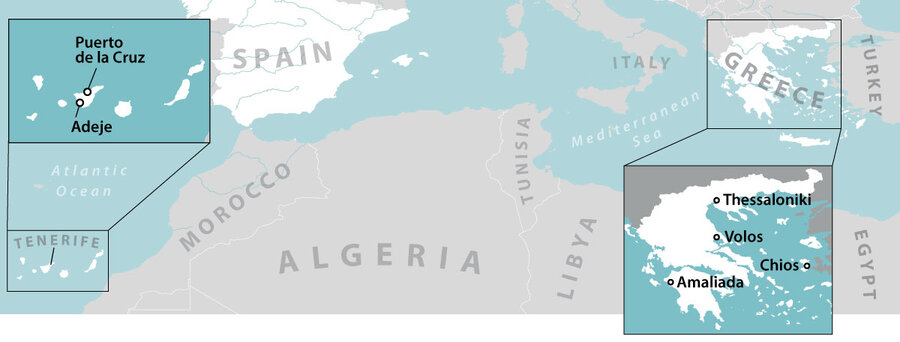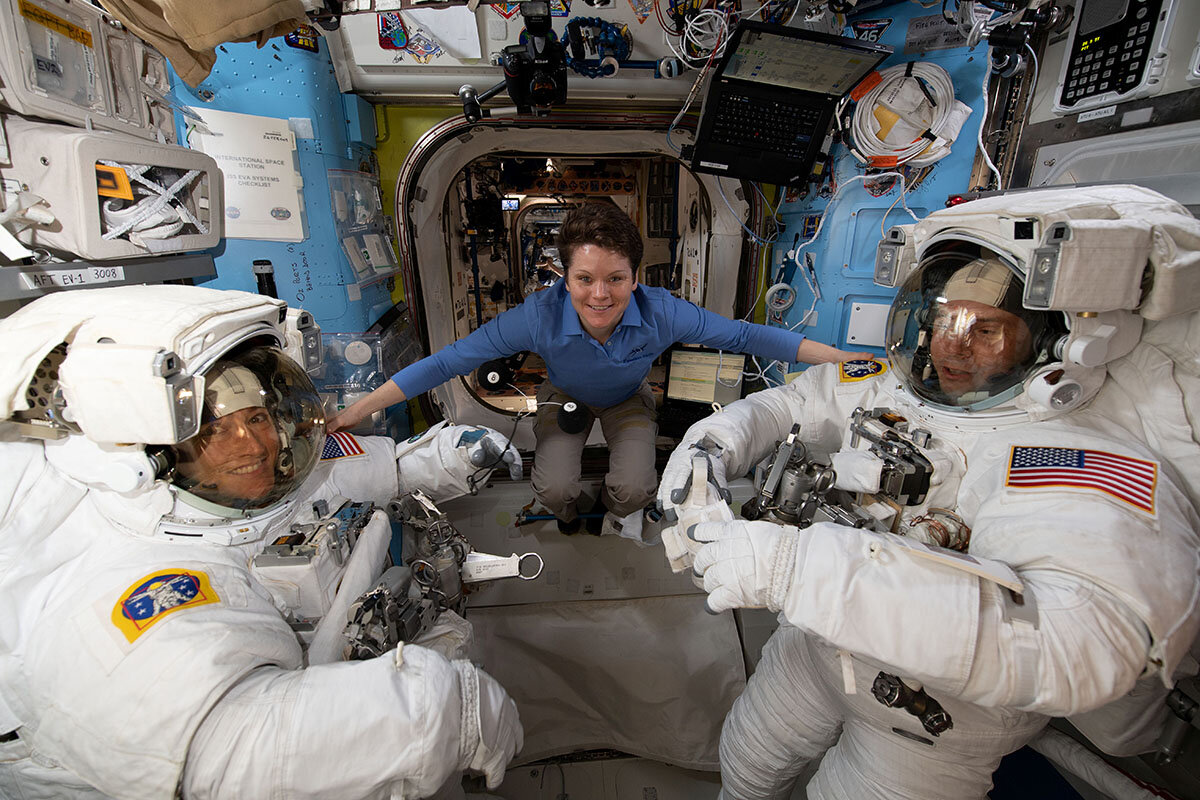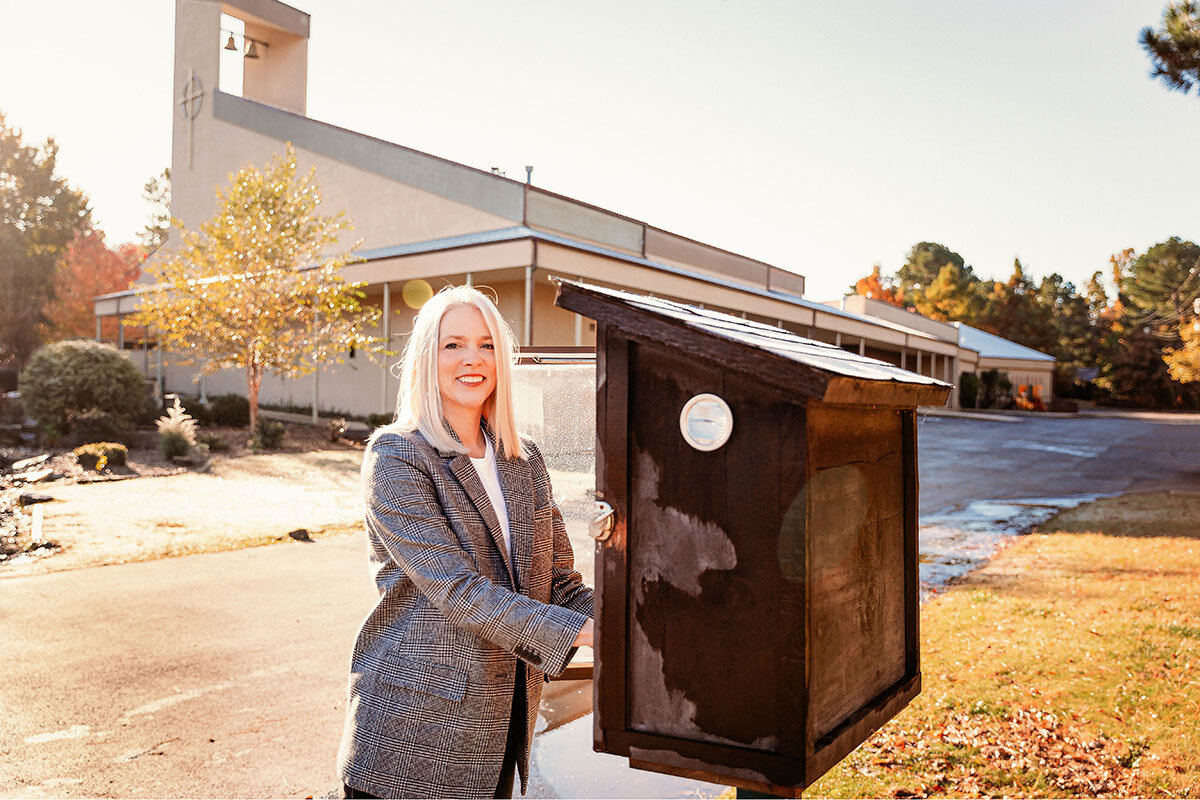- Quick Read
- Deep Read ( 6 Min. )

Why is Christian Science in our name?
Our name is about honesty. The Monitor is owned by The Christian Science Church, and we’ve always been transparent about that.
The Church publishes the Monitor because it sees good journalism as vital to progress in the world. Since 1908, we’ve aimed “to injure no man, but to bless all mankind,” as our founder, Mary Baker Eddy, put it.
Here, you’ll find award-winning journalism not driven by commercial influences – a news organization that takes seriously its mission to uplift the world by seeking solutions and finding reasons for credible hope.
Explore values journalism About usIn Today’s Issue
- This Georgia city beat back COVID-19. It wishes states would pay attention.
- Europe’s tourism test: How do you bring back tourists, safely?
- NASA’s spacesuits have a gender problem. These women are fixing it.
- With Little Free Pantries, neighbors feed neighbors in need
- Home theater: Films bring Paris to your living room
Monitor Daily Podcast
- Follow us:
- Apple Podcasts
- Spotify
- RSS Feed
- Download
TODAY’S INTRO
A national mask mandate? Why Walmart isn’t waiting.
A family member posted this smile-inducing quote on Facebook Monday:
“Calm down! Walmart is just asking you to wear a mask. You can still wear your pajamas, and leave your bras and teeth at home.”
After talking to family and friends, I'm persuaded that those who refuse to wear a mask in public don’t trust the pandemic science, coronavirus death tallies, or the news media. Distrust looms large. Most do not know anyone who has experienced COVID-19. They may also have a distaste for the government telling them what to do, especially about health care. In a nation built on the ideal of independence, that should come as no surprise.
The anti-maskers remind me of those who don’t trust climate science or vaccines. But surveys show they are a shrinking minority. And as politicians prevaricate on masks, we’re seeing corporations – similar to climate policy – take the lead. On Monday, Walmart, CVS, Publix, and Kohls joined Starbucks, Krogers, and Best Buy among national retail chains requiring all customers to wear masks.
Masks are inconvenient. But they may be “the cheapest forms of stimulus ever designed by humans,” economist Austan Goolsbee told The Washington Post. Robert Kaplan, president of the Federal Reserve Bank of Dallas, said that masks are the key to reopening the economy.
Retailers apparently agree. And yes, you can still shop in your pjs.
Share this article
Link copied.

Help fund Monitor journalism for $11/ month
Already a subscriber? Login

Monitor journalism changes lives because we open that too-small box that most people think they live in. We believe news can and should expand a sense of identity and possibility beyond narrow conventional expectations.
Our work isn't possible without your support.
This Georgia city beat back COVID-19. It wishes states would pay attention.
Our reporter visited a community in Georgia that conquered a COVID-19 outbreak. Among their lessons for America: unity across racial lines, humility, and decisive action.

Four months ago, Albany, Georgia, was rocked by COVID-19.
The small city of 75,000 people developed one of the most intense outbreaks of the coronavirus in the United States in the pandemic’s early days. Cases linked to several funerals held in late February and early March spread and overwhelmed Albany’s health care capacity, in one of the first known instances of a “super-spreader” event in the country.
At one point, Dougherty County had the fourth-highest infection rate in the world. But citizens banded together across racial lines, adopted preventive measures, and beat back the virus, say local leaders.
During a visit, Georgia Public Health Commissioner Kathleen Toomey praised the community’s response. She said that the city “already knows the lessons we want everyone to follow through the state.”
It’s unfortunate that states such as Texas, Florida, and Arizona largely didn’t heed the important lessons taught by Albany and other concentrated outbreaks, says city commissioner Demetrius Young. Those include: Simple health measures can corral COVID-19 spread, and humility is important. The coronavirus doesn’t know red states from blue, Mr. Young points out.
“I think we are in a good position ... because of the way that we came together,” says Commissioner Young.
This Georgia city beat back COVID-19. It wishes states would pay attention.

Four months ago, Albany, Georgia, was rocked by COVID-19.
The small city of 75,000 people – and surrounding Dougherty County, a rural area in the state’s southwest – developed one of the most intense outbreaks of coronavirus in the U.S. in the pandemic’s early days. Cases linked to several local funerals held in late February and early March spread and overwhelmed Albany’s health-care capacity, in one of the first known instances of a “super-spreader” event in the country.
At one point, Dougherty County had the fourth-highest infection rate in the world. National Guard medical teams descended on the area to aid in what became a Southern equivalent of New York City’s epic fight. Over 150 people died.
But citizens banded together across racial lines, adopted preventive measures, and beat back the virus, say local leaders. The county’s rolling number of daily average cases dropped from a peak of 55 in late March to about 3 in late June.
Editor’s note: As a public service, all our coronavirus coverage is free. No paywall.
Cases have ticked up some lately as Georgia’s state outbreak has worsened. They’re still far below March’s highs, however. And Demetrius Young, an Albany City commissioner, believes that having lived through one out-of-control outbreak, area citizens will be better prepared to rally together and prevent another.
“Right now, we are poised to handle probably more of a surge than any other place that didn’t get hit like we did,” says Mr. Young, whose mother, Mary Young-Cummins, was a political legend in the region.
It’s unfortunate that states such as Texas, Florida, and Arizona, largely didn’t heed the important lessons taught by Albany and other concentrated outbreaks, he says. Those include: simple health measures can corral COVID-19 spread, and humility is important. Don’t think you’re immune, and that the virus only affects other kinds of people, in other cities, in far-away states.
The singularly American failure to contain the virus and reopen its economy can in part be traced to America’s reluctance to learn from its own experience, and to distrust rooted in politicization. But coronavirus doesn’t know red states from blue, Mr. Young points out.
“People kind of thought, ‘Well, that’s happening over here but not happening over here.’ But the way this virus works is that the water is still going to reach you,” says Mr. Young. “It is going to find its way there. That’s the nature of it.”
Birthplace of a movement
The birthplace of the Albany Movement, a desegregation and voters’ rights coalition founded in 1961 that set the stage for the Rev. Martin Luther King, Jr.’s, later protests, Albany is a majority-black city, largely segregated, where power and wealth is still concentrated in the white community.
It is part of the Black Belt, a term popularized by Booker T. Washington to refer to the fertile crescent of land running through 11 Southern states. Today, 32% of residents live in poverty – compared with 12% nationally. Like so many cities and towns across the U.S., its neighborhoods range from the neat, gated streets of the northern suburbs, to the disinvestment and decay of a southeastern area of the city known as Darkside.
And when the virus hit, the Black population – beset by chronic economic and health disparities, including lack of access to health care – suffered the most. Ninety percent of those who died in Albany were Black.
At the time of the initial outbreaks, much of the city’s political structure, including its mayor, were somewhat dismayed at the public health information coming from the level of the state, says Mr. Young.
But when cases rose sharply in March only the need for a concerted community-wide response mattered.
“We were suddenly in a situation that demanded drastic measures,” he says.
Michael Fowler is a local pastor who also serves as county coroner. At the height of the outbreak he “had the toughest job in the country,” according to Governor Kemp.
One thing Dr. Fowler says he learned from that experience was to move fast.
“I think we jumped on it by offering daily information about modes of transmission and death rates, and we said people have to stand together, and many of them did come together,” he says.
They learned that the entire community needs to adopt simple prevention measures to beat back the virus and send the case curve downward.
“It can’t just be a few people wearing masks,” he says.
During a visit two weeks ago to Albany, Georgia Public Health Commissioner Kathleen Toomey praised the community’s response to its initial outbreak. She said that the city “already knows the lessons we want everyone to follow through the state.”
The state may need to pay attention to Albany’s example because coronavirus cases in Georgia have swung sharply upward since the end of May.
On June 1, Georgia’s seven-day rolling average of new cases was 620. On July 20, it was 2,979.
To Albany’s political leaders this surge means they can’t rest on their laurels. They’ve fought one big battle but the war isn’t over.
“I think we keep doing what we’re doing,” says Dr. Fowler. “There might be another surge, or a new virus. We’ve got to learn to live with it.”
“People took it seriously”
Right now, Georgia politics is riven by a dispute between Governor Kemp, a conservative Republican, and Atlanta’s Democratic mayor, Keisha Lance Bottoms, over masks and other preventive measures.
On July 10, Mayor Bottoms – a potential vice-presidential pick for presumptive Democratic nominee Joe Biden – issued an ordinance returning Atlanta to phase 1 of its reopening. Among other things the ordinance mandated the wearing of face masks in public.
Governor Kemp has filed suit and is requesting an injunction that would bar Ms. Bottoms from enforcing her order, or talking about her alleged authority to do so. Georgia’s cities are barred from issuing coronavirus rules that are more restrictive than those promulgated by the governor, according to the suit.
Albany, which has a white mayor, has not tried to override the governor on masks. But it doesn’t have to, says Commissioner Young.
“It was so bad here that we don’t need a mandatory thing,” says Mr. Young. “Everybody is masking up pretty well. The businesses responded. We were in a good position where people took it seriously.”
Having experienced the pandemic firsthand, local restaurateurs have gone beyond state standards and designed a set of local standards and restrained openings. During the initial surge local nonprofits popped up to procure personal protective equipment so small business owners could find and afford protections for their staff and customers. (Eventually, local government stepped in with grants to help pay for those supplies.)
Mr. Young has said Governor Kemp should not intervene with local governments on the choices they make to protect their communities, and that if things really get worse, a mask mandate might be beneficial. But he adds that he realizes that there are strong feelings on the mask issue, on both sides.
“And you have to factor that in,” he says.
Albany’s experience will help it deal with the continued pandemic, according to Mr. Young. He says the COVID-19 surge also highlighted racial and economic disparities in the area, since the Black community was hit so hard. The city council has begun a plan to improve health outcomes across the region, in part to improve community pandemic defenses.
“I think we are in a good position ... because of the way that we came together. And I also think things are very hopeful ... in terms of what this virus has exposed,” says Commissioner Young.
Editor’s note: As a public service, all our coronavirus coverage is free. No paywall.

Europe’s tourism test: How do you bring back tourists, safely?
Our reporters take you to three Mediterranean tourist spots to see how European resorts and restaurants are balancing economic revival with public health concerns.

- Quick Read
- Deep Read ( 7 Min. )
-
Dominique Soguel Special correspondent
With much of Europe tentatively returning to a semblance of normal life after several months of pandemic-induced lockdown, the opportunity for travel during the summer season has returned.
But while resort towns like Spain’s Puerto de la Cruz, reliant on tourism, are keen to try to make ends meet by courting travelers who dare hop on a plane, they must balance that against the serious public health concerns that remain. Though a vital source of livelihood for travel destinations, tourists also are a potential conduit for a COVID-19 outbreak to be introduced into the community.
Ultimately, 2020 will be at best a “salvage operation,” argues Tom Jenkins, CEO of the European Tourism Association. Northern European beach destinations that can be reached overland will fare better, he says, while Mediterranean beach resorts, especially those dependent on airlines for access, will struggle.
“As this business in 2020 is highly last minute, it is difficult to make a prediction, but it is highly unlikely that they will have more than 50% of their normal volume,” he says. “Everyone is pinning their hopes on a return to a normality (of sorts) in 2021. Many of the bookings for 2020 have been moved into that year.”
Europe’s tourism test: How do you bring back tourists, safely?

Alberto Coll Suárez races around the patio of Meraki, a disposable face mask hanging precariously in the balance as he clears coffee cups and saucers from a handful of tables. Mr. Coll Suárez’s cafe-bar in this tourist town has been nearly full since reopening July 13. Business is better than expected, but concerns about the coronavirus linger on.
“I’m anxious,” he says. “The movement of so many people means we don’t know what will happen.”
With much of Europe tentatively returning to a semblance of normal life after several months of pandemic-induced lockdown, the opportunity for travel during the summer season has returned. But while resort towns like Puerto de la Cruz, reliant on tourism, are keen to try to make ends meet by courting travelers who dare hop on a plane, they must balance that against the serious public health concerns that remain.
Editor’s note: As a public service, all our coronavirus coverage is free. No paywall.
Though a vital source of livelihood for Puerto de la Cruz and its kind, tourists also are a potential conduit for a COVID-19 outbreak to be introduced into the community. Or reintroduced in the case of the island of Tenerife, where Puerto de la Cruz lies, as the nearby town of Adeje was the site of one of the earliest major outbreaks in Europe.
“I love being around people and I want to work but it’s dangerous for me, my son, friends and family,” says Mr. Coll Suárez. “I could potentially be contagious to my loved ones. … I need to open my business but the fear is always there.”
Caution in the Canary Islands
Spain’s Canary Islands region depends on airlines to bring tourists. Only 341 routes are planned for the month of July, as opposed to the 770 before the pandemic. The tourism sector is expected to operate at 30% of capacity compared to last summer, when the loss of 28,000 lives due to COVID-19 had yet to cast a shadow across Spain.

Meraki had only been open for six months when the lockdown started on March 14. Mr. Coll Suárez had little time to prepare financially, but got by thanks to some savings and government aid. With most of his money tied up in the bank loans that helped launch the cafe, he desperately needs the business to succeed. Except for help on Sundays, he works up to 14 hours, six days a week solo.
Most of the clients at Meraki have crossed the street from the Hotel Turquesa Playa, one of the most successful hotels in Puerto de la Cruz, a town in the north of the island.
The doorman here takes the temperature of everyone who enters; a mask is required in the common areas, and bottles of hand sanitizer sit just beyond the door. While the hotel restaurant is open, clients are not allowed to touch anything and table service has replaced the traditional buffet dining.
Guests say these protocols make them feel safe. One couple from Madrid finds it to be safer in Tenerife – where there are very few COVID-19 cases – than back home. Eugenia Petrova, a German tourist who was among the first tourists to arrive in town July 1, finds restrictions here similar to those in Berlin.
“We were not so sure what to expect,” says Ms. Petrova, who traveled with her husband and two children and whose need for a vacation proved greater than coronavirus fears. “When we arrived, there were only three or four families in the hotel. There were no people around, and not many hotel services. The shops were closed. Now it’s starting to become more normal.”
Further south, Adeje boasts the highest concentration of five-star hotels in Europe. It is fighting hard to restore its image after making headlines in February when the H10 Costa Adeje Palace had to confine over 1,000 people to their rooms after an Italian doctor and his wife tested positive for the virus.
“We are working to show this summer that Adeje and the Canary Islands are a safe destination,” says Adolfo Alonso Ferrera, the Adeje councillor for tourism and sport. To that end, the H10 Costa Adeje Palace hosted the head of the World Tourism Organization and dozens of travel journalists to showcase the health protocols adopted across the archipelago.
Frustrations in Greece
Greece is another destination trying to reassure tourists. The tourism season officially opened on June 15 and international flights began reaching regional airports July 1. The Mediterranean nation boasts one key advantage: It defied expectations in its pandemic response. The virus claimed fewer than 200 lives in Greece compared to nearly 35,000 in Italy.
When Nikos Karaflos converted a disused wine factory and launched the beachfront Dexamenes Seaside Hotel in 2019, near the town of Amaliada and the Olympia archaeological site, he was proud of its look. The reception, bar, and restaurant are all open plan. Guest suites are located in concrete former wine tanks – so no corridors, no elevators. “The setup of the hotel was in a magical way like a COVID-19 proof design,” says Mr. Karaflos.

He is grateful to be open even if finances are tough. Front desk staff wear a face shield to welcome guests; waiters and cleaners sport masks and gloves. Tables are spaced out beyond the recommended distance. Visitors are gifted complementary masks. And each room is assigned a specific sun lounger and umbrella.
Guests who cancel – and there have been many – are offered vouchers for 2021.
“It was a great shock in the beginning,” he says, looking back to February and March. “Afterwards, it was a lesson in life, so that we appreciate what we have.”
“We see a good vibe from our guests, that [is] the most rewarding part of this season,” he adds. “Everybody needed to let off steam, relax, … and eat well.”
Dimitris Mamadas has two hotels open year-round in mainland Greece. They cater to a mix of tourists and business travelers. He was expecting 2020 to be an “extremely good year” with a projected net profit of €1.2 million ($1.37 million). The coronavirus crisis means he is facing losses to the tune of €500 million instead.
The Aegli hotel in the port town of Volos is faring best, with a 55% occupancy rate, thanks to Balkan tourists who are coming overland. However, a spike in COVID-19 cases associated with these travelers has led Greece to tighten restrictions – barring Serbians and requiring new arrivals from Bulgaria to present a negative COVID-19 test issued in the last 72 hours.
At the Porto Palace in Thessaloniki, experiences with guests have been frustrating, as some expect normal services and are disappointed to learn saunas, hot tubs, and indoor pools are off-limits. “The bad thing is that people who are traveling right now are not afraid of COVID,” says Mr. Mamadas. “They think that everything has passed but it is not the case.”
Giorgos Mylonadis, who runs studio apartments in the Greek island of Chios, is following government health protocols while waiting for ferry activity to resume with Turkey so longtime customers can visit before winter. “People are afraid to travel,” he worries. “If people do not stop having this fear, whatever we do they will not travel.”

“Salvage operation”
Ultimately, 2020 will be at best a “salvage operation,” argues Tom Jenkins, CEO of the European Tourism Association. Northern European beach destinations that can be reached overland will fare better, he says, while Mediterranean beach resorts, especially those dependent on airlines for access, will struggle.
“As this business in 2020 is highly last minute, it is difficult to make a prediction, but it is highly unlikely that they will have more than 50% of their normal volume,” he says. “Everyone is pinning their hopes on a return to a normality (of sorts) in 2021. Many of the bookings for 2020 have been moved into that year.”
Back in Tenerife, the reopening of the European borders has sparked conflicting feelings among locals. Maria Acevedo opened her artisanal jewelry shop Tuqueque in 2018. With one of the shop doors leading directly into the Hotel Turquesa Playa, she relies almost entirely on tourism to make ends meet.
Since reopening at the end of June, she keeps a strict health protocol. Masks are required to enter, jewelry is disinfected and put on a tray for clients to try on, and the shop is constantly ventilated. While she is excited to be back at work, the pace of business has been disappointing.
“It’s been hard,” says Ms. Acevedo, who scraped by on government aid during the lockdown period. “People are scared [to travel] and I’m a little scared too because I don’t know which way things are going to go.”
Tenerife is taking no chances. Masks remain mandatory in all indoor spaces. Many grocery stores take temperature readings at the door. And locals are increasingly wearing their masks to navigate the increasingly crowded town center. Among those erring on the side of caution is Naomi Benavides.
“My friends were teasing me, like why are you wearing the mask outside now? But I started to get nervous,” says the Puerto de la Cruz native. “There are so many people everywhere and you just don’t know where they’ve come from or if they’ve brought the virus with them.”
Editor’s note: As a public service, all our coronavirus coverage is free. No paywall.


NASA’s spacesuits have a gender problem. These women are fixing it.
Sometimes the noblest of goals can get held up for what seem like trivial reasons. Examining those reasons can often reveal a path to progress.

- Quick Read
- Deep Read ( 4 Min. )
For the first time in history, an entirely female team of astronauts was about to embark on a spacewalk last spring. But just days before astronauts Anne McClain and Christina Koch were set to venture outside the International Space Station, NASA swapped a man for Ms. McClain, saying they didn't have spacesuits that would work for both women ready to go.
Barriers to equality can be baked into industries through infrastructure, like the spacesuits. But that failed attempt may also represent the long-term progress that has been made toward including women at NASA more readily – and in workplaces in general.
The first all-female spacewalk attempt helped “throw into sharp relief long-standing circumstances that are about gradual change,” says Margaret Weitekamp, chair of the space history department at the Smithsonian National Air and Space Museum. But it also “shows, in some ways, the maturity of the program and the persistent presence of women in it.”
Despite the initial stumble, two women came up for the spacewalking job once again. In October 2019, astronauts Ms. Koch and Jessica Meir finally took that history-making step outside the space station.
NASA’s spacesuits have a gender problem. These women are fixing it.
It was going to be a historic moment: Last spring, for the first time, an entirely female team of astronauts was to embark on a spacewalk.
But just days before Anne McClain and Christina Koch were to venture outside the International Space Station, NASA swapped Ms. McClain for a man. They’d realized there weren’t two spacesuits ready that would work for both women.
That reversal drew scorn. Instead of being a moment to celebrate the agency’s progress toward gender equality, it seemed to expose how much work remained in supporting female astronauts.
Barriers to equality can be baked into infrastructure, like spacesuits, for years. But what happened with the first attempt at an all-female spacewalk may also represent long-term progress toward including women at NASA – and in workplaces in general.
“Women’s history tends to proceed with these fits and starts,” says Margaret Weitekamp, chair of the space history department at the Smithsonian National Air and Space Museum and author “Right Stuff, Wrong Sex: America's First Women in Space Program.”
The first all-female spacewalk attempt helped “throw into sharp relief long-standing circumstances that are about gradual change,” Dr. Weitekamp says. It also “shows, in some ways, the maturity of the program and the persistent presence of women in it.”
A minor alteration
In the 1960s, NASA’s spacesuits were custom made for individual astronauts, who, at the time, were all men. In the 1970s, the agency’s priorities shifted and more astronauts flew, so NASA opted for spacewalking suits – officially called extravehicular mobility units, or EMUs – that could be used by multiple astronauts to save money and time. These suits are modular, with separate pieces for arms, legs, and torsos. Women, the thinking went, could fit into the same sizes made for smaller men.
That plan might have worked acceptably, but later budget cuts led to NASA slashing some of the sizes, leaving only the mediums and larges. During the space shuttle era, astronauts who didn’t fit the available sizes could still participate in missions, but they couldn’t do a spacewalk, says former astronaut Bonnie Dunbar. But that changed with the International Space Station, as all astronauts are expected to perform spacewalks.
Before launching, Ms. McClain had trained for spacewalks underwater like every other astronaut, testing out different-sized suits. But once aboard the space station, she had the opportunity to do a spacewalk (with a male astronaut), and after experiencing true microgravity, she realized she needed a different torso size.

Sizing is very important, says Dr. Dunbar, who flew on the space shuttle five times and now is director of the Aerospace Human Systems Laboratory at Texas A&M University. “If [the joints of the spacesuit] are not in the right place, you have to really work at it to make it bend,” sometimes making it impossible to function in the suit at all.
A request to tweak a spacesuit once aboard the space station is “not uncommon,” says Lindsay Aitchison, a NASA spacesuit engineer. But the first all-female spacewalk attempt was scheduled for a few days later, and reconfiguring the life-support system to a different torso piece would take too long. The crew decided together to change who did the spacewalk, Ms. Aitchison says.
“It is actually a sign of women’s secure and equal standing in the astronaut corps that Anne McClain was able to make the call that she did, even after all of the public pressure of the publicity,” Dr. Weitekamp says. “For her to be able to say 'the equipment doesn’t fit me and I won’t be able to perform well' means that she knew they wouldn’t just yank her from the rotation.”
A universal suit
Recently, women have held some of the highest offices at NASA, and are designing the next generation of spacewalking suits.
Last fall, NASA revealed new spacesuits designed for the Artemis program, in which the agency aims to land the first woman on the moon. Those new suits, called exploration extravehicular mobility units, or xEMUs for short, will still be modular, says Ms. Aitchison, who leads the design team. But the team uses digital renderings of about 100 body shapes and sizes as a guide.
“We’re designing spacesuits for humans, not men or women specifically, just humans. But over the years, we’ve really had to evolve our thinking about what that means. It’s kind of a shift from thinking not just of men as bigger women or women as small men,” Ms. Aitchison says. “Our bodies are truly different.”
Recent classes of astronauts have been roughly half women. “They’re the future of the space program,” says Amy Foster, associate professor of history at the University of Central Florida and author of "Integrating Women Into the Astronaut Corps." So systems are being designed with them in mind.
One small step
But the aerospace industry more broadly hasn’t yet reached parity. And the fields (research, science and engineering, and the military) that people start in before becoming astronauts are still mostly male.
"The opportunities are there," Dr. Dunbar says, now it's just about recruiting and encouraging more young people – regardless of gender.
In October 2019, two women had come up for the spacewalking job once again, and astronauts Ms. Koch and Jessica Meir performed the first all-female spacewalk.
It’s something to celebrate, says Dr. Foster. “It’s one of those hopeful things that I’m proud that I got to witness.”

Difference-maker
With Little Free Pantries, neighbors feed neighbors in need
Charitable acts are often contagious. Inspired by Little Free Libraries, our reporter profiles an Arkansas woman who leveraged the concept – and the same community spirit – to address hunger. Today, thousands of mini food pantries help feed those in need.

- Quick Read
- Deep Read ( 5 Min. )
-
By David Conrads Correspondent
It was during one of her regular runs that Jessica McClard noticed the first Little Free Library in her hometown of Fayetteville, Arkansas. The homemade book exchange boxes had been proliferating all over the country. She became fascinated with them, and wanted to translate her interest in food insecurity into a similar project.
Thus the idea for the Little Free Pantry was born, a free-standing cabinet with shelves and a door, mounted on a post. It’s filled with nonperishable food and personal hygiene products. Anyone can put up a pantry, take from the pantry, and donate to the pantry.
With a microloan of $250, Ms. McClard installed the first Little Free Pantry on the grounds of her church in May 2016. Within months, more than 100 pantries had sprung up across the country.
Today there are hundreds in the U.S. as well as an estimated 3,000 pantries worldwide in countries like Canada, Australia, the Netherlands, and Thailand.
“It takes all of us to make this work,” she says. “It’s only together that we do it. ... We all need each other.”
With Little Free Pantries, neighbors feed neighbors in need
Jessica McClard is an avid runner and reader.
It was during her runs that she noticed the first Little Free Library in her hometown of Fayetteville, Arkansas. The homemade book exchange boxes had been proliferating all over the country. Soon there were four such libraries within walking distance of her home, situated in her middle-class neighborhood in a college town. She became fascinated with the Little Free Libraries and thought a lot about why she was drawn to them.
“These little free spaces create a place to be neighborly again,” she says. “And that is something that some of us really, really want. If that’s the case, and it’s as much about the space as the books, then anything might go inside it.”
It didn’t take her long to figure out exactly what she wanted to put inside such a space. Ms. McClard has a long-standing interest in poverty justice and a keen awareness of the prevalence of food insecurity in Northwest Arkansas. She was part of a giving circle at the elementary school her two daughters attended, helping provide food to students in need.
“All of those things clicked,” she says. “I knew what I was going to do.”
Thus the idea for the Little Free Pantry was born.
The concept couldn’t be simpler. A Little Free Pantry can take many forms, but typically it’s a free-standing cabinet with shelves and a door, mounted on a post. It’s filled with nonperishable food and personal hygiene products. Anyone can put up a pantry, anyone can take from the pantry, and anyone can donate to the pantry.
With a microloan of $250, Ms. McClard installed the first Little Free Pantry on the grounds of her church in Fayetteville in May 2016. Things moved quickly from there. She created a Facebook page for the project and within a few days her story was picked up by the local media. Two weeks later, someone unknown to Ms. McClard put up a second pantry in another part of town. Soon a third pantry popped up 300 miles away in Ardmore, Oklahoma. Within months, more than 100 pantries had sprung up across the country and the concept had gone international, with a Little Free Pantry reported in New Zealand.
“I really had no idea how fast it would happen,” Ms. McClard says. “I hoped that people would take the concept and run with it, and that’s exactly what happened.”
A way to give back
Today there are hundreds of pantries in the U.S. as well as in countries such as Canada, Australia, the Netherlands, and Thailand. Ms. McClard estimates there are more than 3,000 pantries worldwide, though the exact number is impossible to know.
She attributes the popularity and rapid expansion of the mini pantries to a number of factors. The Little Free Libraries, which started in 2009, primed many people to the concept of a public space where neighbors connect with neighbors, anonymously and with little organization.
“It’s not a difficult project to execute,” she says, “but it also invites participation without having to execute. It’s an easy way for a lot of people to give back to their communities. For a lot of people, it’s difficult to write a $25 check, but when they get paid, they might pick up an extra can of green beans and put it in the mini pantry. That happens all the time.”
Ms. McClard’s pantry is entirely open source. There are no schedules or sign-up sheets. Friends and community members stock the pantry when they are moved to do so. Other pantries and networks of pantries are more organized.
While her pantry has always been active, she has seen a spike over the past few months, both in how often it is emptied and in the number of new pantries opening up worldwide.
“COVID has people looking to do something and this is something that people can do,” she says. “Social distance is built in, so you really don’t need to be close to someone to help through these spaces. I feel like it’s the mini-pantry moment.”
“We all need each other”
Gretchen Davis started a mini pantry in Columbus, Ohio, in 2018, impelled by a desire to create a volunteer opportunity for her four children. In 2 1/2 years, the Columbus Blessing Boxes Project has expanded to 60 mini pantries covering much of central Ohio.
“Jessica’s idea to put out a food pantry to help those in need – no questions asked, no signing up, a place anyone can go whenever it’s convenient – was a fantastic idea,” Ms. Davis says. “People are sometimes reluctant to ask for help,” she adds, noting that the mini pantries break the traditional provider-client relationship model.
Mini pantries are not intended to take the place of food banks, which are far larger and have the capacity to serve much greater numbers of people. Since mini pantries are small, they cannot stock the quantity and variety of foods that would be available at a food bank, nor are the contents of a mini pantry predictable.
“Minis are a gap-filler,” Ms. McClard says, adding that many food pantries require recipients to go through means testing, to determine if they are needy enough to receive benefits. “There are a lot of people experiencing food insecurity who do not pass a means test,” Ms. McClard says. “Minis are a place people can go when they can’t go somewhere else.”
“I see Little Free Pantries sitting alongside traditional sources of food,” says Molly Harmon, a chef in Seattle who used a microgrant to build and install six mini pantries last March. That project has since ballooned to 74 pantries located within a 30 miles radius of the city.
“Circumstances are different for everyone and they are a nonjudgmental way to get food,” Ms. Harmon says. “They’re open 24/7. There’s no ID required. It’s food by neighbors for neighbors, so the likelihood of finding culturally relevant foods is higher. And it’s an anonymous access point, so anyone can come and get food.”
The mini-pantry movement has earned the respect of much larger hunger relief organizations. Brenda Shaw is the chief development officer of the Lowcountry Food Bank in Charleston, South Carolina, which services 300 partner agencies in a 9,000 square mile territory. Last year, the food bank served more than 200,000 people and distributed over 32 million pounds of food.
“I think [mini pantries] certainly address a need, especially for emergency food assistance,” Ms. Shaw says. “If someone can’t get to a larger pantry or to the food bank itself, mini pantries provide our neighbors in need with food immediately, which is a very good and honorable thing to do.”
Ms. McClard maintains a website that offers guidance on topics like building and locating a mini pantry, as well as a map showing the location of many of the pantries. She is in the process of launching an online marketplace that she expects to be live later this summer, www.pantrygift.org, that supports the mini-pantry movement by allowing people to make tax-deductible donations to individual pantries or pantry networks, or to create fundraising campaigns.
“If it were just me, that box out there would be nothing more than a kind gesture to somebody,” she says. “It takes all of us to make this work. It’s only together that we do it. I need them. We all need each other.”

On Film
Home theater: Films bring Paris to your living room
With international travel on pause, especially for Americans, movies offer a way to satisfy our wanderlust. Film critic Peter Rainer suggests you take a motion picture tour of Paris: “Even if you’ve been there, you may discover, as I did, that you experience the city through cinematic eyes. Love of movies and love of Paris are, for many of us, inextricably entwined.”

-
By Peter Rainer Special correspondent
Home theater: Films bring Paris to your living room
I’ll admit it: I am perfectly content to see an otherwise mediocre movie as long as it’s set in an alluring locale. Especially these days, movies can serve as passports to places otherwise out of reach. Few destinations are more scenic or romantic than Paris, which is why I’ve chosen the City of Lights to kick off this itinerary.
So many films – good ones – have been set in Paris that untravelled moviegoers may nevertheless feel like they know the place. Even if you’ve been there, you may discover, as I did, that you experience the city through cinematic eyes. Love of movies and love of Paris are, for many of us, inextricably entwined.
Editor’s note: As a public service, all our coronavirus coverage is free. No paywall.
There are so many movies I could cite that are much more than mere travelogues. Jean-Pierre Jeunet’s “Amélie” (2001) utilized some 80 locations and yet never felt like a scenic tour. The cameras in Jean-Jacques Beineix’s thriller “Diva” (1981) zoomed up, down, and around the fabled Metro stations. Jean Renoir’s “Boudu Saved from Drowning” is a great comedy that is also a priceless photographic record of 1930s Paris. Woody Allen’s “Midnight in Paris” (2011) contrasted the modern day city with re-creations of the bistros and drawing rooms of the expat Lost Generation of Hemingway and Fitzgerald. Richard Linklater’s “Before Sunset” (2004) did for Paris what his earlier “Before Sunrise” did for Vienna. And of course, when Rick and Ilsa in “Casablanca” flash back to happier times, it’s Paris that we see.
Here are a few favorites for home viewing this week.
“Charade”
Stanley Donen’s 1963 romantic mystery caper, “Charade,” stars Cary Grant and Audrey Hepburn at their most iconic. Like all the films I’m citing in this column, it can be enjoyed apart from its Parisian pedigree, but why not take in the sights anyway? Con man Grant teams with the recently widowed Hepburn to retrieve a stolen fortune while pursued by a trio of menacing crooks. All this and Henry Mancini’s famous theme song, too. The Seine, as is true for just about every Paris-set movie, is on full view, along with an outdoor market and a Punch and Judy marionette show in a garden park in the Champs-Élysées. My favorite dialogue exchange between the two stars comes during an evening boat trip on the Seine:
Grant: “Oh you should see your face.”
Hepburn: “What’s the matter with it?”
Grant: “It’s lovely.”
Hepburn made quite a few other films set in Paris, some – like “Sabrina,” “Love in the Afternoon,” and “Funny Face” – memorable. The latter, also directed by Donen, starring Hepburn and Fred Astaire, displayed in pleasingly untouristy ways the Louvre, the Eiffel Tower, Notre Dame, and the Arc de Triomphe. (Unrated)

“An American in Paris”
Most of “An American in Paris,” a 1951 Vincente Minnelli musical replete with great Gershwin tunes, was filmed not in Paris but on the soundstages of MGM. But this fact only reinforces the idea that, for many of us, Paris is more a state of mind than an actual city. The re-creations complement our romantic imaginings. Gene Kelly plays a struggling expatriate painter and Leslie Caron, making her movie debut, is the winsome object of his amour. (Caron had previously danced in Roland Petit’s Ballets des Champs-Élysées company.) Seven years later she triumphed in another Parisian musical, “Gigi.” The Kelly-Caron pas de deux on the banks of the Seine, choreographed to “Our Love is Here to Stay,” is one of the most moving of all musical numbers. The final 17-minute wordless ballet sequence incorporates the canvases of such great French painters as Renoir, Dufy, Utrillo, and Toulouse-Lautrec. (Unrated)
“Breathless”
Unlike “Charade” and “An American in Paris,” Jean-Luc Godard’s 1960 debut feature, “Breathless,” was filmed in black and white with lightweight equipment on the streets of Paris in an improvisatory style far removed from Hollywood. And yet the movie is a sideways tribute to low-budget American gangster movies and Humphrey Bogart. Jean-Paul Belmondo is an amoral drifter who hides out from the police in the Paris apartment of his sometime girlfriend, played by Jean Seberg, an American student at the Sorbonne who hawks copies of the International Herald Tribune on the Rue Campagne-Première. The film is one of the crown jewels of the French New Wave. (Unrated, with English subtitles)
Peter Rainer is the Monitor’s film critic.
“Charade,” “An American in Paris,” and “Breathless” are available on at least one of these platforms: Amazon Prime Video, YouTube, Google Play, iTunes.
Other headline stories we’re watching
(Get live updates throughout the day.)The Monitor's View
Protecting the innocent – from Bosnia to China
- Quick Read
- Deep Read ( 2 Min. )
-
By the Monitor's Editorial Board
On Monday, the United States took action to protect a minority in China from mass detention and forced labor. The U.S. action comes as many world leaders commemorated the 25th anniversary of the worst atrocity in Europe since the Holocaust. In July 1995, more than 8,000 Muslim men and boys in the Bosnian town of Srebrenica were slaughtered by Serbian forces. The world’s reluctance to intervene, along with its indifference during Rwanda’s genocide a year earlier, led the United Nations to later endorse the idea of collective intervention in any country experiencing large-scale killing.
Western countries have struggled, however, in applying this principle of protecting innocent civilians from gross human rights violations. Stopping China’s ruthless campaign against the Uyghurs in the Xinjiang region may be one of the biggest challenges. Invasion is not an option. The U.S. is left with sanctions and highlighting China’s atrocities – such as forced abortions – in international forums.
The global embrace of the idea that innocent lives must be protected may have weakened. But as the Chinese government further tries to destroy the Uyghur people, the world – or at least the U.S. – has put a fresh spotlight on a humanitarian principle.
Protecting the innocent – from Bosnia to China

On Monday, the United States took action to protect a minority in China from mass detention and forced labor. It barred 11 Chinese companies from buying American technology without a special license, citing their complicity in China’s campaign against its Muslim minority. The action is commendable on its own. It aims to end what many regard as a slow genocide of 1 million or more members of a religious group. Yet on a grander scale, it helps revive a fading ideal in global affairs: the responsibility to prevent mass atrocities.
The U.S. action comes as many world leaders commemorated the 25th anniversary of the worst atrocity in Europe since the Holocaust. In July 1995, more than 8,000 Muslim men and boys in the Bosnian town of Srebrenica were slaughtered by Serbian forces over 11 days. The world’s reluctance to intervene, along with its indifference during Rwanda’s genocide a year earlier, led the United Nations to later endorse the idea of collective intervention in any country experiencing large-scale killing.
Western countries have struggled, however, in applying this principle of protecting innocent civilians from gross human rights violations. The 2011 NATO intervention in Libya to protect an entire city left that country in tatters. But the world largely stood by as Syria used chemical weapons on its own people. And it has done little to end abuses in Myanmar against a Muslim minority, the Rohingya.
Stopping China’s ruthless campaign against the Uyghurs and other Muslim groups in the Xinjiang region may be one of the biggest challenges. Invasion is not an option. The U.S. is left with sanctions and highlighting China’s atrocities – such as forced abortions – in international forums.
Yet the legacy of the Srebrenica massacre hangs over the West’s response to China. The fact that such a mass killing took place in Europe 50 years after World War II – and despite attempts to curb ethnic and religious nationalism on the Continent – was a shock. With Bosnia still suffering political tensions between Muslims, Serbs, and Croats, world leaders are frequently reminded of the work needed to protect minorities. “We cannot let up in working towards genuine reconciliation [in Bosnia],” said U.N. Secretary-General António Guterres on the anniversary.
To the world’s credit, the two main leaders of the Srebrenica massacre have been convicted and sentenced in an international court. Bosnia’s politicians are nudged and cajoled by European and American diplomats.
The global embrace of the idea that innocent lives must be protected may have weakened. But as the Chinese government further tries to destroy the Uyghur people, the world – or at least the U.S. – has put a fresh spotlight on a humanitarian principle.

A Christian Science Perspective
Each weekday, the Monitor includes one clearly labeled religious article offering spiritual insight on contemporary issues, including the news. The publication – in its various forms – is produced for anyone who cares about the progress of the human endeavor around the world and seeks news reported with compassion, intelligence, and an essentially constructive lens. For many, that caring has religious roots. For many, it does not. The Monitor has always embraced both audiences. The Monitor is owned by a church – The First Church of Christ, Scientist, in Boston – whose founder was concerned with both the state of the world and the quality of available news.
Nothing can mask our spiritual goodness
- Quick Read
- Read or Listen ( 3 Min. )
-
By Kathy Chicoine
In these days of face masks and what may seem like the masking of good in others, here are some ideas on how we can keep seeing our neighbor from a spiritual standpoint.
Nothing can mask our spiritual goodness
Everywhere we go there are people wearing masks, and our once-familiar world appears quite upside down! But masks cannot change the nature and character of any one of us, any more than Halloween masks hide the innocence of the children ringing doorbells looking for treats. Seeing their little smiles trying to hide behind an array of brightly stitched costumes doesn’t fool us, when we know beneath each mask is a child whose joy and innocence are still intact.
Masks can appear in deeper forms; they are not only physical. During a birthday party for our grandson many years ago, my then daughter-in-law became upset when she learned one of the invited children was bringing a cousin who she remembered as rude and selfish. She was convinced this little girl would ruin the party.
Instead of agreeing with her, I asked that she might give this little girl a chance and expect good behavior. Then, I began to pray and affirm that all God’s children are naturally generous, obedient, and kind, because they reflect God’s nature. Understanding this was how I began to strip off – unmask – the disguise of an unruly child.
I’ve learned through Christian Science that the nature and character of each one of us is the expression of divinity. We are spiritual, not material, complete, not fragmented. If we want to see this perfection in others, we must start by affirming what is spiritually true about them as the expressions of God, Spirit. Otherwise, we are mistaking an imperfect appearance for the reality.
Mary Baker Eddy, the founder of the Monitor and author of “Science and Health with Key to the Scriptures,” included a chapter in her book that indicates a spiritual way of understanding certain words as they appear in the Bible. The chapter defines “children,” in part, as “the spiritual thoughts and representatives of Life, Truth, and Love” (p. 582). This truth applies to each one of us. It does not matter what one’s background or history is. What does matter is the fact that we are each made in the image and likeness of God, divine Love. Ever-present Love alone defines us and expresses in us qualities such as wisdom, goodness, spirituality, and grace.
Well, thinking along these lines made all the difference, and, as I expected, the party went on without any problems. In fact, it was noted at the end how lovely this little girl had been. She was generous and kind. It was a complete turnaround from what this mother had feared.
Science and Health states, “It is ignorance and false belief, based on a material sense of things, which hide spiritual beauty and goodness” (p. 304). As we drop a false material sense and gain a spiritual sense of our and others’ true individuality, we begin to understand the laws of Love that govern everyone. This spiritual sense assures us that, in reality, spiritual beauty and goodness cannot be hidden by any mask, physical or mental. The Bible tells us we can never be separated from God, the very source of love itself!
No matter what the guidelines are as our communities reopen, and despite what is paraded in front of us, nothing can keep us from demonstrating the power and presence of divine Love in our daily lives. While working toward the goal of getting back into a normal routine, and enjoying the company of friends and strangers alike, it might be helpful to remove the masks mentally first – to see beyond any false claim about our neighbor that may present itself to our thought. Instead, let’s see the children of God as God sees them – uncontaminated, unafraid, confident, and joyful. We will find this acknowledgment goes a long way, just as it did with that little girl all those years ago.
Editor’s note: As a public service, all the Monitor’s coronavirus coverage is free, including articles from this column. There’s also a special free section of JSH-Online.com on a healing response to the global pandemic. There is no paywall for any of this coverage.

A message of love
Going, going ...

A look ahead
Thanks for joining us. Come back tomorrow: We’ve got a story about demonstrators overseas offering advice to American protesters on how to stay safe while confronting brutal police states.



